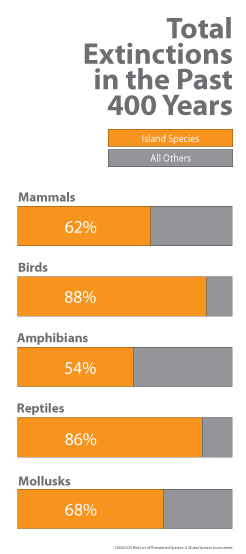“One of the swiftest and most profound biological catastrophes in the history of the earth.”
That’s how eminent biologist Storrs Olson describes the stunning rate of species extinctions on islands over the past several centuries, during which 80% of all recorded extinctions happened to island species.

The extinction crisis that threatens our planet is most acute on islands, where most animal extinctions in the past 500 years have occurred. Because islands are isolated, many new species evolve on them—and those species are extraordinarily vulnerable. Even a small, localized environmental disruption can wipe out an entire species if that species lives on only a single island.
Islands take up only five percent of Earth’s land, but are home to an estimated 20 percent of the world’s bird, reptile, and plant species. And almost 40 percent of critically endangered animals live on islands.
At the same time, island communities are under constant pressure to boost economic development, even at the cost of environmental damage. Many of the world’s most vulnerable islands are small, remote, and often overlooked.
All Seacology projects help protect island species, which include some of the world’s rarest plants and animals. Just a few examples of what we’re working to save:
- nesting beaches of giant leatherback turtles
- the rainforest habitat of the critically endangered silky sifaka lemur in Madagascar
- the San Salvador iguana in the Bahamas
Get island news
Subscribe to Seacology’s newsletter for monthly updates about about our projects, to be notified about upcoming events and travel opportunities, and more.

